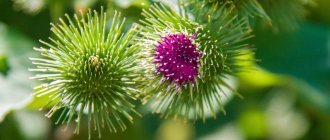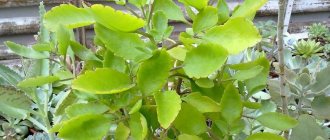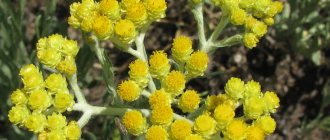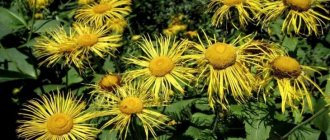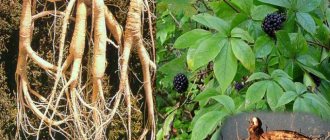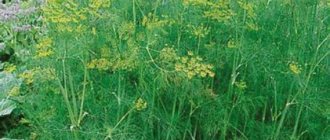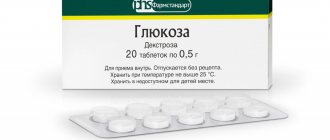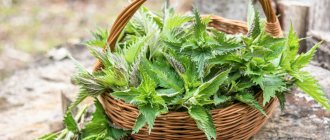Rhodiola is a genus of perennial plants from the Crassulaceae family. The genus branches into an average of 90 species, but Rhodiola rosea has become the most popular. The composition of the plant has attracted the attention of pharmacology, cosmetology, perfumery and even the sports industry. Rhodiola was nicknamed the “golden root”, included in the Red Book, and control over the cultivation and use of the component was strengthened.
What is hidden behind the unsightly Rhodiola flowers and how can the plant be of interest to the consumer?
General characteristics of the plant
Rhodiola rosea is a perennial herbaceous plant. Acceptable name is rose/golden root. The etymology of the alternative name is simple - the rhizome of the plant is painted the color of old gold, which gives off a specific pearlescent sheen.
Botanical description
Rhodiola is a succulent dioecious plant with a powerful horizontal rhizome and miniature oblong adventitious roots. Erect stems emerge from the dense rhizome. In total, up to 15 stems with a height of 10 to 40 centimeters can develop. Rhodiola with a single stem is extremely rare. The leaves are alternate, sessile, and acquire an elliptical shape of an elongated egg; less often, pointed leaves with a solid edge or a serrated upper part are found.
Content:
- General characteristics of the plant
- Features of the composition
- Rhodiola as an adaptogen
- Pharmacological action of the plant
- Application of the component in various industries
- Possible harm and contraindications for use
Inflorescences are formed from several yellow flowers. They are painted in a bright yellow shade. Later, greenish, erect fruits form from the flowers. Rhodiola blooms from June to July. Fruit ripening occurs in July-August. The plant reproduces in two ways: vegetative and seed.
Rhodiola is not particularly demanding on environmental conditions. The main thing is that the plant receives the necessary amount of moisture. Abundant flowing moisture is the key to high-quality growth and development of fruits. Rhodiola does well without a lot of heat or sunlight. This does not affect the quality, chemical composition and beneficial properties of the plant.
Territorial distribution
The plant prefers cold, temperate climates. The largest percentage of Rhodiola plantings are concentrated in North America, Ireland, Great Britain, the Alps, the Carpathians, the Pyrenees, Altai, the Urals, on the coast of the White/Barents Sea and in the mountainous regions of Siberia.
Brief historical background
Ancient Chinese emperors mounted massive expeditions to Altai and other mountainous regions to obtain golden root. In addition to high-ranking government officials, Rhodiola was the subject of interest for smugglers. They found plantings, plucked everything they could steal and smuggled goods across the border. Previously, Rhodiola root was considered the greatest rarity, and its cost was several times higher than the price of gold.
In Altai there is still a proverb: “Whoever finds the golden root will live up to 120 years in health and happiness.”
Contraindications of Rhodiola rosea for women
Anyone interested in Rhodiola rosea and contraindications to its use should remember the following. Taking supplements with Rhodiola is strictly contraindicated for hypertension, mental disorders, fever, and epilepsy. The use of golden root preparations is also contraindicated for children under 12 years of age. When taking medications in the afternoon, you may experience increased blood pressure, headaches, and insomnia.
When used together with other adaptogens, Rhodiola rosea tends to increase their side effects, so even when prescribing such drugs together, it is necessary to reduce their dosage.
The use of alcohol tinctures is contraindicated for people with alcohol addiction, liver disease, pregnant and lactating women.
So, if you feel tired and urgently need to gather your strength, the wonderful plant Rhodiola rosea will certainly help you! And in many other situations, golden root preparations will come to your aid, but when taking them, you must strictly follow the dosage recommended by the manufacturer of the drug.
Features of the composition
About 140 biologically active components are concentrated in the underground part of the plant. Roots and rhizomes contain phenols and their derivatives. Phenols are the end of the side group of tyrosine, and therefore are part of the vast majority of protein molecules. The composition includes organic acids (succinic, citric, oxalic, malic), carbohydrates (fructose, glucose), aromatic compounds (cinnamic alcohol, rosin), essential oils (citral, phenylethyl alcohol, geraniol, cinnamaldehyde). The composition is also rich in flavonoids, tannins, steroids and beneficial nutrients.
Rhodiola, growing in different countries, may have different compositions and opposing properties.
Is on the verge of extinction
Lily of the valley
The plant has small, fragrant white flowers on long stems that grow from tufts of leaves. Don't be fooled by the delicate appearance of lily of the valley flowers. This is a frost-resistant and fast-growing flower. Toxic to people and animals!
All parts of the plant, including its orange-red fruits that often tempt children and pets, contain cardiac glycosides, which affect the heart. Toxins are most concentrated in the roots. However, even ingesting small amounts of the berries or other part of the plant can cause serious illness and sometimes death. Wild animals usually avoid the lily of the valley.
Feather grass
Feather grass is a perennial plant with bare leaves framed by a tuft of hairs at the end. The height can vary between 20-40 cm. It blooms in late May - early June.
In Russia, there are about 80 species of feather grass, although there are many more of them around the world - about 300. They are distinguished by an erect stem and narrow leaves along it.
Panax ginseng
In Russia, the medicinal plant is called the divine herb, the salt of the earth, the wonder of the world, the gift of immortality and the root of life.
In eastern countries, indications for the use of the root are the following conditions: decreased performance, exhaustion, chronic fatigue, excessive physical exertion, mental retardation. Helps in the treatment of heart disease, neurasthenia and anemia. Eastern doctors believe that it is capable of prolonging people's lives.
Interestingly, the root of the plant retains its beneficial properties throughout the cold season, during the period when the above-ground parts of the medicinal plant die off.
The healing properties of ordinary ginseng have been known since ancient times. Subsequently, it began to be used in many countries around the world. Once ginseng was recognized in official medicine, due to the increased need for its roots, its quantity decreased. Now it is classified as a rare plant species. Currently, the wild plant is under protection.
yellow water lily
Water lilies are not only beautiful flowers, but also play many useful roles in nature. Many rare and endangered species live on them. For example, many birds nest on leaves on the surface of the water, and fish hide underneath them.
This delicate flower has disappeared from the wild due to overexploitation of its habitat.
Saffron
Saffron is an expensive spice that is widely used in the production of confectionery, cooking, medicine and cosmetics. It is grown mainly in the Middle East, South and East Asia and in smaller quantities in southern Europe.
Saffron is the golden stigma of the autumn crocus (Crocus sativus), which is dried and used as a seasoning to flavor foods and as a dye for coloring. Saffron has a strong exotic aroma and bitter taste.
Ginseng
Ginseng is a perennial herb with strong taproots. Typically, plants die back in the fall and emerge from the root system again in the spring. The leaves are palmately compound with 3–5 leaflets, the margins of which may be entire, serrated or lobed, depending on the species. The inflorescence is a single umbel (flat-topped cluster of flowers) with bisexual and male flowers. The fruit is a drupe. Cultivated ginseng plants typically take 5–7 years to mature from seed.
Ginseng has a sweet and aromatic taste. Its root has long been considered a panacea for illnesses by the Chinese, although it was generally used by them for preventive purposes rather than for medicinal purposes. The effects of ginseng include improved mental performance, learning, memory and sensory perception.
Ginseng is protected by the Convention on International Trade in Endangered Species, which calls on the federal government to certify annually that harvesting the root does not threaten its existence.
Common heather
Heather is a common plant in heathland, marshes and even forests with acidic or peaty soils. Its delicate pink flowers appear from August to October and contrast with the tough, stringy, spreading stems on which they grow. Plants grow closely together and can live up to 40 years or more.
The flower, leaf and top of the plant are used to make medicine.
People drink heather as a tea for kidney and lower urinary tract problems, prostate enlargement, fluid retention, gout, arthritis, sleep disorders, breathing problems, coughs and colds. They also take it for digestive disorders such as diarrhea, cramps and stomach pain (colic), as well as liver and gallbladder diseases. It is sometimes used to induce sweating.
In combination with other herbs, heather is used to treat diabetes, menstrual discomfort, menopause and nervous exhaustion. Other uses include stimulating digestion and regulating the circulatory system.
Some people add heather to bath water to treat wounds.
Kandyk Siberian
Siberian Kandyk is a perennial herbaceous honey plant of the lilac family. Grows in Siberia, Altai, Altai Territory, Mongolia, Central Asia. Prefers alpine meadows, rocky slopes, deciduous and coniferous forests, forest glades. In many localities, the Siberian kandyk is listed in the Red Books .
At the end of April - beginning of May, the kandyk blooms with beautiful purple flowers. This plant is also valued in folk medicine; all parts of the plant are used as medicinal raw materials: stems, leaves, flowers and bulbs.
Volodushka Martyanova
The plant is 50 to 120 cm tall with a slightly branched dark brown rhizome. The stems of this species are straight, green with a purple tint. Martyanov's inflorescences are complex umbrellas of small inflorescences, each of which consists of 10-15 yellow flowers.
Thanks to the substances that make up the plant, it has: immunostimulating, anthelmintic, antimalarial, tonic, antitumor, antioxidant, laxative, astringent, antiseptic, anti-inflammatory, wound-healing, antipyretic and tonic properties.
Rhodiola as an adaptogen
The first impression of the term “adaptogen” can be quite misleading. This is not a new technological development, but the name of a group of plants that have been known for their medicinal properties since ancient times. Adaptogens come to us from Ayurveda and traditional Chinese medicine. This group of plants has not lost its popularity and inexhaustible benefits for several centuries.
What are they and how do adaptogens work?
Adaptogens solve problems with hormonal imbalance, increased levels of emotional and physical stress. These are three battlefields in which the powers of ordinary plants play an extremely important role. Adaptogens affect the functioning of the sympathetic nervous system, thyroid gland and adrenal glands. As soon as the work of these organs and systems is aligned, the whole body is healed.
The uniqueness of the group of adaptogens is revealed by their name. After entering the body, they adapt to the individual characteristics of a person and bring the entire internal space into balance. They give energy to a tired person or calm to an overly excited person.
Regulation of the production of hormones and enzymes by adaptogens affects:
- cholesterol level;
- liver and heart;
- breathing process;
- immune system;
- brain cells;
- nervous system;
- age-related changes.
Functions of Rhodiola as an adaptogen
This is one of the few adaptogens that has been sufficiently researched and valued in the post-Soviet space. The plant is a natural antidepressant, the spectrum of action of which is much wider than that of pharmaceutical medications. Rhodiola not only normalizes cortisol levels, but helps normalize sleep and food intake, despite the stress experienced. After taking pharmaceutical medications, a person feels exhausted and tired, which makes it difficult to return to their usual routine. The mild effect of a natural adaptogen ensures a quick and painless transition from a state of stress to natural activity.
What else is useful for Rhodiola rosea:
- increases physical endurance;
- increases mental focus capabilities;
- fights early aging of the body;
- copes with excess fat deposits;
- protects against pathogenic radioactive exposure and toxic chemicals.
What is golden root
The homeland of Rhodiola rosea is Altai, but it is also grown in China, Bulgaria, and Mongolia. The herbaceous plant is considered a dioecious succulent from the Crassulaceae family. The root of Rhodiola rosea is very large, painted in a bronze, gilded tone. Many appendages should grow from it. On the surface there is a small herbaceous part, consisting of many stems of different heights with leaves, it looks like a flower. At a certain period, inflorescences are formed, on which the fruits subsequently ripen. Dig up the root twice a year.
Pharmacological action of the plant
In evidence-based medicine, alcohol extract and various extracts from Rhodiola rosea are used. The active components of the plant are used for:
- stimulation of the central nervous system;
- medications for asthenic and neurasthenic conditions;
- tablets for increased fatigue (also used for mentally healthy patients);
- medications for functional pathologies of the nervous system;
- rehabilitation manipulations.
It has been proven that Rhodiola protects red blood cells from the harmful effects of stress and increases the body's resistance to depression and fatigue. The plant stimulates the central nervous system, improves neuroprotective properties and prevents significant loss of stem cells.
The hydroalcoholic extract of the plant helps the body wean itself off drugs. The component “erases” the habit of drug use, and upon subsequent use it produces an ambiguous reaction - nausea, vomiting, a sharp increase in temperature, tremor, headache, and an unstable psychological state. Scientists claim that the extract helps quit smoking, treats opium addiction and has an anti-stress effect on the body during overeating.
What else is the herbal component useful for:
- reduces the overall level of anxiety;
- improves brain activity;
- prevents the development of a number of diseases (from colds to cancer);
- treats sexual disorders;
- increases endorphin levels.
Price
The product can be bought at a regular pharmacy or ordered online. Its price depends on the release form and volume you choose. The approximate cost is shown in the table:
| Release form of rosea rhodiola | Price in rubles |
| Tincture, 0.5 l | 320-650 |
| Extract, 30 ml | 57-141 |
| Tablets, 40 pcs. | 140-168 |
Application of the component in various industries
Cooking
The product is used extremely rarely in the gastronomic industry. It is not profitable for large industrial companies to regulate the planting and use of a plant for which additional control has been established. Only the above-ground part of the plant can be used as a food product, but its taste and structure cannot be called a gastronomic breakthrough. More often the component is used as an adaptogen, medicinal or cosmetic component.
Medicine
The plant is included in preparations for:
- oxygen starvation;
- respiratory infections;
- diabetes mellitus;
- gout;
- fever;
- diseases of the teeth and oral cavity;
- jaundice;
- hypotension;
- problems of the skeletal system;
- neuroses, schizophrenia.
Cosmetics and perfume industry
Clinical medical studies on humans have confirmed the safety and benefits of Rhodiola. The component is especially effective on sensitive and aging skin. Rhodiola extracts are used in face, body and hair care products.
Creams based on Rhodiola stimulate skin renewal, slow down the aging process, increase the skin's ability to withstand aggressive external environments - ultraviolet radiation, pathogenic microorganisms, toxic chemical compounds.
Recommendation: the quick and effective effect of medicinal cosmetics based on Rhodiola will be noted by people with sensitive, irritated and damaged skin. For normal, dry and oily skin, it is best to choose cosmetics with a different range of actions.
After contact with the skin, the extract begins to act. First, metabolic processes are regulated, then energy metabolism in cells is stabilized. Oxidation of fats and carbohydrates occurs, due to which the skin tone is evened out and blackheads disappear. The regeneration process starts and gains momentum, and the barrier functions of the dermis increase. A few hours after application, the feeling of tightness and dryness disappears. After a few days, peeling goes away, after the course the skin’s water balance, elasticity, color, and protective functions are restored.
Sports industry
Preparations based on Rhodiola rosea tone/stimulate not only nervous but also muscle activity. They significantly increase your performance and will help you gain/lose a few kilograms, improve your results before a competition, or run a long-awaited marathon. Long-term use of the component really strengthens the muscle corset, making a person more resilient and strong.
When to use Rhodiola rosea for healthy people:
- when overworked;
- during the rehabilitation period (after infectious/somatic diseases) in order to quickly return to the natural rhythm of life;
- for periods of work that require increased mental activity;
- for maintaining and restoring muscles after/during prolonged intense physical activity;
- during the period of carbohydrate loading before competitions;
- for speedy recovery after training;
- to increase the capacity of the respiratory chain;
- to increase the body's resistance to infections;
- with overtraining.
Use of Rhodiola rosea for women
The use of any products with Rhodiola rosea extract should be strictly according to the instructions, preferably after consulting a doctor. Based on what goal you are pursuing, the mode of administration and use of one or another form of the drug is determined - whether it will be a tincture, liquid or dry extract, or a decoction, tea or tablets.
Most doctors and competent trainers know what Rhodiola rosea is and how women should take it. Like many adaptogens, it is best to take this supplement before training, or in the morning, and avoid taking it in the evening, as Rhodiola can cause insomnia. Rhodiola rosea has properties that allow active women to feel more energetic, which is especially important for anyone who has small children.

